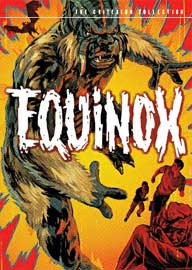 EQUINOX
(1970)
EQUINOX
(1970)It took the pages of Famous
Monsters of Filmland to bring together Dennis Muren and David Allen, two
talents who would later go on to become innovative forces in the special effects
arena. As motivated young men in the mid 1960s, they set out to make a feature
similar to the numerous monster films they’d been exposed to, and the
results would be what we know today as EQUINOX. A favorite amongst monster movie
and stop motion animation fans who either caught it on the big screen, gazed
at it on late-night local television, or owned the 10-minute Super 8 film version,
EQUINOX has finally made it to DVD in a deluxe two-disc edition; an incredible,
loving presentation from The Criterion Collection. 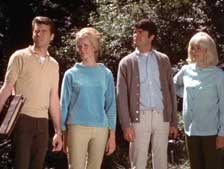
A reporter visits David Fielding (Edward Connell) who is an asylum a year and one day after some tragic, mysterious events. Listening to a tape recording of David talking to a doctor, we learn that he and three friends – Jim Hudson (Frank Boers Jr., aka Frank Bonner), Susan Turner (Barbara Hewitt) and Vicki (Robin Christopher) – had gone deep into the woods to visit college professor Dr. Waterman (famed sci-fi writer Fritz Leiber) at his cabin. When they arrive, they discover that the cabin has been destroyed, and Waterman nowhere to be found. After exploring a dark cave, they are given an ancient book by a giggling old man, and when they open it, a Pandora’s Box of devilish nightmares occur. Demonic forces come in the form of several gargantuan creatures, a satanic park ranger, medieval castles that disappear and wall of mist that apparently leads to another dimension.
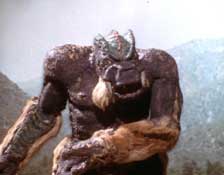 That
is the basic plot of EQUINOX, at least the version released theatrically in
1970. Beginning in 1965, Dennis Muren (who served as effects photographer, producer,
director and co-writer) along with friends Dave Allen (who conceived most of
the stop motion animation), Mark McGee (who wrote the bulk of the script and
co-directed) and Jim Danforth (who is responsible for the very impressive mattes
and cel animation) shot a homegrown monster film in 16mm in scenic California,
with the help of some inexperienced actors and other locals. Completed in 1967
and titled “The Equinox… A Journey into the Supernatural,”
the finished product ran about 70 minutes long, and Muren struggled to find
a distributor interested in picking it up for theatrical release. That opportunity
came when legendary producer Jack H. Harris (THE BLOB, THE 4-D MAN, DINOSAURAUS)
liked what he saw, taking on the film and bringing in director Jack Woods (who
also would write the new dialog and appears as a new character, Asmodeus) to
shoot new scenes with the central cast, brought back after more than a few years.
That
is the basic plot of EQUINOX, at least the version released theatrically in
1970. Beginning in 1965, Dennis Muren (who served as effects photographer, producer,
director and co-writer) along with friends Dave Allen (who conceived most of
the stop motion animation), Mark McGee (who wrote the bulk of the script and
co-directed) and Jim Danforth (who is responsible for the very impressive mattes
and cel animation) shot a homegrown monster film in 16mm in scenic California,
with the help of some inexperienced actors and other locals. Completed in 1967
and titled “The Equinox… A Journey into the Supernatural,”
the finished product ran about 70 minutes long, and Muren struggled to find
a distributor interested in picking it up for theatrical release. That opportunity
came when legendary producer Jack H. Harris (THE BLOB, THE 4-D MAN, DINOSAURAUS)
liked what he saw, taking on the film and bringing in director Jack Woods (who
also would write the new dialog and appears as a new character, Asmodeus) to
shoot new scenes with the central cast, brought back after more than a few years.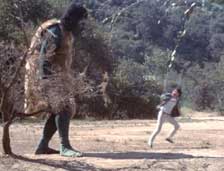
The two films are very different. For the released version, some plot points were tossed out to make room for other expanded concepts, a new menacing character was written in, optical effects were added, voices were re-dubbed, scenes were re-edited, different music was utilized, etc. Actually, what Harris and Woods did was commendable, cleverly edited and revised, bringing the running time up to 80 minutes. Whatever version you might think is more worthy (here, you get to compare the two as they’re both included), it’s the special effects that make this such an admired and remembered effort. The stop-motion monsters include a Kong-inspired ape-like creature, a dragon-like tentacled creature that devours a house and demon winged bat creature, instrumental during the film’s climax. A green giant in fur skins is played by an actor in make-up and costume, but making him appear colossal while knocking down mortals is one of the film’s most innovative yet simple achievements. For most who worked on EQUINOX, this was their maiden voyage, and it shows in the film’s many flaws, and even the effects tend to be crude and far from polished. But there’s something very fascinating about it, like an attempt to clone a studio Ray Harryhausen production by ambitious amateurs with no money, throwing in any ideas they could muster up from the old horror films they grew up on, with a dash of H.P. Lovecraft tossed into the mix. And that’s basically what it is, and it’s a charming, inspiring spectacle of low budget fantasy movie history.
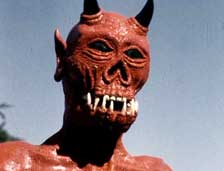 The
1970 theatrical version of EQUINOX is presented full frame (any matting would
have marred the image drastically) and looks quite good, especially considering
that it was shot entirely on 16mm and then blown up to 35mm. The image has been
cleaned up considerably and there is a great level of picture detail, with bright,
corrected colors. Anyone used to old video versions or TV airings will be elated
by this new high definition transfer. The audio is also extremely clear, with
only minimal background hiss to be found. The 1967 version, “The Equinox
. . . A Journey into the Supernatural,” apparently has been transferred
from different sources, including a 16mm duplicate negative and 16mm composite
print (both supplied by Muren), and for a few brief shots, a VHS tape. Naturally,
this version looks rougher and not nearly as good as the theatrical version,
but it’s still very watchable and its inclusion on this set is invaluable.
The
1970 theatrical version of EQUINOX is presented full frame (any matting would
have marred the image drastically) and looks quite good, especially considering
that it was shot entirely on 16mm and then blown up to 35mm. The image has been
cleaned up considerably and there is a great level of picture detail, with bright,
corrected colors. Anyone used to old video versions or TV airings will be elated
by this new high definition transfer. The audio is also extremely clear, with
only minimal background hiss to be found. The 1967 version, “The Equinox
. . . A Journey into the Supernatural,” apparently has been transferred
from different sources, including a 16mm duplicate negative and 16mm composite
print (both supplied by Muren), and for a few brief shots, a VHS tape. Naturally,
this version looks rougher and not nearly as good as the theatrical version,
but it’s still very watchable and its inclusion on this set is invaluable.
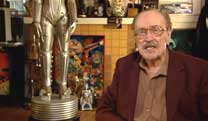
Extras on the first disc include a video introduction by legendary Famous Monsters founder/editor Forrest J. Ackerman. At almost 90 years of age, Uncle Forry is still as enthusiastic about monster fandom as ever, talking about how he met the young makers of the film through his magazine, that he suggested Fritz Leiber to star in it, and his bit part in it, doing a doctor’s voice heard on a tape recorder. Two commentaries are included. The original 1967 version features Dennis Muren, and recorded separately, Mark McGee with Jim Danforth. The three gentlemen cover every basis about making the film with zero money, revealing the techniques behind the special effects and matte shots, construction of the sets (it’s amazing to learn they built a convincing cave in Muren's backyard!), the cast, locations and much more. Proud of their accomplishments, they shed a humorous light on the film’s shortcomings and its original $6,500 budget (much of which was donated by Muren’s granddad, who also appears as a crazy old hermit). The other audio commentary is included on the 1970 version, and features producer Jack H. Harris (no stranger to special effects movies) and writer/director Jack Woods, who discuss why they decided to distribute the film and the new footage that they shot for it. Giving us a different perspective on what became the final released version, they share some good anecdotes, and Woods at one point remarks that he shot expanded TV scenes for some of Roger Corman’s Allied Artists films!
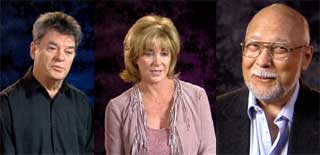 The
second disc compliments the two versions of the film with an abundance of fine
supplements. Silent outtakes (7:05) from the original version not only display
different takes from the shooting, but also shows the cast and crew having a
few laughs, as well as a deleted poolside party where a bikini-clad blonde dances
on top a diving board before a group of beer-swilling youths. Test footage (1:49)
of the “Taurus” (the off screen name given to Dave Allen’s
ape-like creation) has him escaping from Griffith Park, followed by his assault
on a nearby suburban neighborhood. Forry Ackerman can be seen briefly at the
beginning. Also tagged on here is some test footage of Allen’s animated
skeleton (the first stop-motion model that he actually built). A video interview
with Dennis Muren (7:29) has him discussing his childhood fascination with special
movie effects, leading to his short experimental films, setting out to make
a full-length effects-laden feature with his buddies, going to Jack H. Harris
to release it, and later, meeting George Lucas and getting involved with STAR
WARS, which lead to him being one of today’s leading visual effects artist
The
second disc compliments the two versions of the film with an abundance of fine
supplements. Silent outtakes (7:05) from the original version not only display
different takes from the shooting, but also shows the cast and crew having a
few laughs, as well as a deleted poolside party where a bikini-clad blonde dances
on top a diving board before a group of beer-swilling youths. Test footage (1:49)
of the “Taurus” (the off screen name given to Dave Allen’s
ape-like creation) has him escaping from Griffith Park, followed by his assault
on a nearby suburban neighborhood. Forry Ackerman can be seen briefly at the
beginning. Also tagged on here is some test footage of Allen’s animated
skeleton (the first stop-motion model that he actually built). A video interview
with Dennis Muren (7:29) has him discussing his childhood fascination with special
movie effects, leading to his short experimental films, setting out to make
a full-length effects-laden feature with his buddies, going to Jack H. Harris
to release it, and later, meeting George Lucas and getting involved with STAR
WARS, which lead to him being one of today’s leading visual effects artist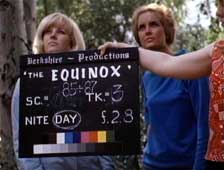 s.
A section of cast interviews (9:37) includes Frank Bonner (who went on to become
a star on “WKRP in Cincinnati” as well as a prominent TV director),
Barbara Laughray (formerly Hewitt) and James Duron (who was heavily made up
as the film’s Green Giant). They talk about their roles in the film (and
in Bonner’s and Laughray’s cases, getting the call-back years later
to reprise their parts), working for no money, and all seem to imply it was
great fun working on it. They all seem impressed by the film’s cult status
and happy to have been involved with it. “Zorgon: The H-Bomb Beast From
Hell” (8:45) is a short silent student film by Kevin Fernan which includes
some key EQUINOX talent (Mark McGee, Dave Allen, and Jim Danforth playing a
drunken old man), as well as Rick Baker. Parts of Baker’s OCTAMAN and
SCHLOCK costumes can be found on the film's monsters, who dwells around Bronson
Canyon (on some of the same locations where EQUINOX was shot). A section entitled
“Dave Allen Appreciation” includes “The Magic Treasure”
(a rarely seen 19-minute animated children’s film by Allen), an essay
about “The Magic Treasure by James Duron, Allen’s famous “King
Kong” animated Volkswagen commercial (featuring Fay Wray’s daughter),
silent test footage from the commercial, and lastly, “Kong at Cascade,”
which is an essay by Chris Endicott about Allen’s days as an animator
at a commercial house in California. The “Equiphemera” section is
one of the most impressive galleries you’ll ever witness, containing everything
from Famous Monsters clippings to behind-the-scenes photos, rare photos
of the puppet models seen in the film and much more, all accompanied by textual
information. The original Jack H. Harris trailer (“Begins where ROSEMARY’S
BABY left off!”) and two different radio spots round out the extras.
s.
A section of cast interviews (9:37) includes Frank Bonner (who went on to become
a star on “WKRP in Cincinnati” as well as a prominent TV director),
Barbara Laughray (formerly Hewitt) and James Duron (who was heavily made up
as the film’s Green Giant). They talk about their roles in the film (and
in Bonner’s and Laughray’s cases, getting the call-back years later
to reprise their parts), working for no money, and all seem to imply it was
great fun working on it. They all seem impressed by the film’s cult status
and happy to have been involved with it. “Zorgon: The H-Bomb Beast From
Hell” (8:45) is a short silent student film by Kevin Fernan which includes
some key EQUINOX talent (Mark McGee, Dave Allen, and Jim Danforth playing a
drunken old man), as well as Rick Baker. Parts of Baker’s OCTAMAN and
SCHLOCK costumes can be found on the film's monsters, who dwells around Bronson
Canyon (on some of the same locations where EQUINOX was shot). A section entitled
“Dave Allen Appreciation” includes “The Magic Treasure”
(a rarely seen 19-minute animated children’s film by Allen), an essay
about “The Magic Treasure by James Duron, Allen’s famous “King
Kong” animated Volkswagen commercial (featuring Fay Wray’s daughter),
silent test footage from the commercial, and lastly, “Kong at Cascade,”
which is an essay by Chris Endicott about Allen’s days as an animator
at a commercial house in California. The “Equiphemera” section is
one of the most impressive galleries you’ll ever witness, containing everything
from Famous Monsters clippings to behind-the-scenes photos, rare photos
of the puppet models seen in the film and much more, all accompanied by textual
information. The original Jack H. Harris trailer (“Begins where ROSEMARY’S
BABY left off!”) and two different radio spots round out the extras.
Inside the packaging is a thick booklet which contains messages from George Lucas and Ray Harryhausen, as well as all-inclusive liner notes by Brock DeShane. Not only is this one of the finest DVD releases of the year, Criterion’s tribute to “the little monster movie that could” will go down as one of the all-time best presentations of a cult movie on the format. (George R. Reis)